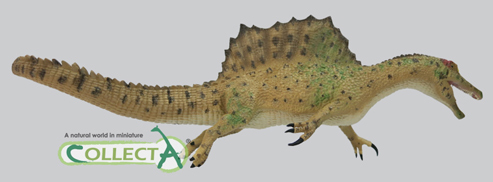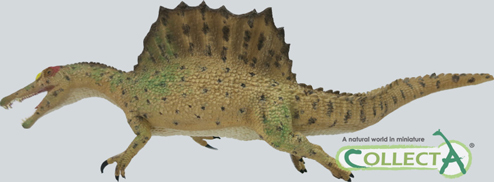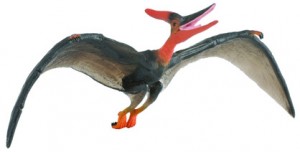Pictures of the Swimming Spinosaurus from CollectA
In addition, to the Deluxe Spinosaurus replica due to be introduced by those clever people at CollectA, two other models of this iconic dinosaur are to be added this year including a swimming Spinosaurus from CollectA. 2015 marks the centenary of the naming of Spinosaurus (S. aegyptiacus), and this event is being commemorated with a couple of new, not-to-scale figures showing Spinosaurus as a quadruped.
A Swimming Spinosaurus Dinosaur Model
The first of these new additions to the CollectA “Prehistoric Life” range depicts Spinosaurus in, what many scientists believe to be its natural habitat – water. Isotope analysis of fossilised remains conducted by a team of scientists, including Romain Amiot (University of Lyon), back in 2010, revealed that spinosaurs may have spent a large portion of their lives in water. The concept of aquatic dinosaurs had once again come into the limelight.
To read an article about a theory that proposes that all dinosaurs were aquatic: Aquatic Dinosaurs.
The Swimming Spinosaurus Dinosaur Model

An aquatic dinosaur? A view of the swimming Spinosaurus from CollectA.
Picture credit: CollectA/Everything Dinosaur
There is other evidence to suggest that Spinosaurus may have spent a great deal of time wadding and swimming in the lakes and rivers of its North African habitat. For example, the Kem Kem region, where many Spinosaurus fossils have been found (Kem Kem Formation of Morocco), was a low-lying area close to the remnants of the mighty Tethys Ocean. It was a wetland habitat, that some scientists have compared to Florida’s Everglades. There were many large lakes and rivers and it is interesting to contemplate, that if one removes the possibility of substantial post mortem transportation of bodily remains, spinosaurid fossils are usually found in sediments that represent ancient lacustrine or riverine environments.
Another View of the CollectA Swimming Spinosaurus

Splashing about – Spinosaurus.
Picture credit: CollectA/Everything Dinosaur
The model, which measures around 26 cm in length, does not stand up on its own. A clear, plastic stand will be provided so that the replica can be displayed. The model is based on the 2014 re-interpretation and review of Spinosaurus fossil remains. Everything Dinosaur team members wrote an article about this new interpretation, on what is regarded as the largest carnivorous dinosaur known to science, back in September.
To read this article: Spinosaurus – Are Four Legs Better Than Two?
How Did Spinosaurus Swim?
The inference from one of the conclusions following the re-interpretation of Spinosaurus as a dinosaur very much at home in the water, is that Spinosaurus was a good swimmer. When our dinosaur experts visit schools to conduct dinosaur themed workshops we often come across pictures of plesiosaurs and ichthyosaurs downloaded in all innocence by the teaching team from on line retailers of teaching resources, these are described as “swimming dinosaurs”. Plesiosaurs and ichthyosaurs are not members of the Dinosauria, and, as far as the fossil record shows, no member of the Dinosauria adapted to a marine environment.
However, like most vertebrates, it is suspected that dinosaurs, if forced to, could swim quite well. There is even some evidence that those ungainly looking pterosaurs could swim, bizarre though it may sound.
A herd of sauropods could cross rivers and estuaries in search of food. Once they had waded out of their depth, these giants could have quite happily paddled their way across. There have even been trace fossils found that have been interpreted as being the scratches and marks made by a dinosaur as it swam across a body of water. The marks being made on the river or lake bed as the reptile occasionally “touched down” only to push itself off again.
To read an article about one of these remarkable trace fossils: Evidence of Swimming Dinosaurs.
Which swimming stroke the Spinosaurus preferred is very much open to debate. The CollectA replica shows an animal swimming in an undulating, sideways motion, with propulsion provided by the long, strong tail. This is reminiscent of the swimming motion of extant crocodilians. In crocodiles, the limbs don’t really play a role in the swimming action. In the absence, of much of the skeleton, what we do have, as investigated by the team of international scientists last year, may have come from very different sized individuals so limb proportions are conjectural to some extent.
CollectA Spinosaurus Model
Could Spinosaurus have adopted a sort of “doggy paddle” approach, swimming with all four limbs? Perhaps, this super-sized dinosaur propelled itself along in the same way as one of the largest land carnivores around today does. Polar bears (Ursus maritimus), technically a marine mammal considering the amount of time they spend on the sea ice, swim with a different motion. They paddle themselves along just using their massive front paws, the back legs provide the steering, a sort of “rear wheel steer”.
We at Everything Dinosaur are not aware of any papers having been published with regards to the proposed swimming action of the Spinosauridae, perhaps one will be published soon.
To view the range of CollectA prehistoric animal figures stocked by Everything Dinosaur: CollectA Prehistoric Life/Prehistoric World Figures.





